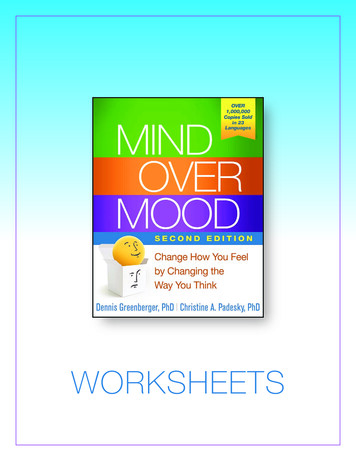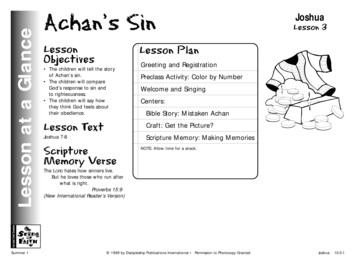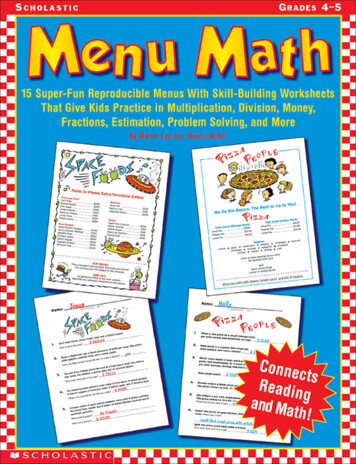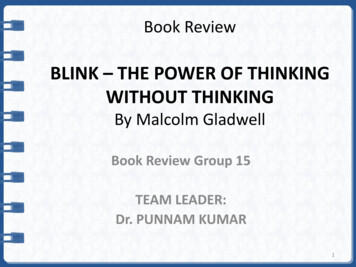
Transcription
WORKSHEETS
How to UseThese WorksheetsYou can use these worksheets either by printing them out and completing by hand, orfilling them out onscreen and then printing. If filling out onscreen, we recommend firstsaving the PDF file to your computer and then opening it in Adobe Acrobat or the freeAdobe Reader program. You can use the Tab key to progress through the fields, and thefont size in the text boxes will automatically decrease to allow you more room as youtype. Please note: if you plan to save the filled-out worksheets, some older versions ofAdobe Reader may not allow this. Please test your version to see whether you are ableto save a completed or partially completed worksheet.Some of the worksheets call on you to circle or mark some of the text you’ve written. If you’re completing the forms onscreen, you can do this by putting [brackets] or*asterisks* around the marked text.A few of the worksheets do not have interactive fields for completion onscreen( Worksheets 13.2, 14.2, 15.2, and 15.7). We suggest that you print these worksheets andcomplete them by hand. Alternatively, some PDF software has a freehand pencil toolthat you can use to complete these worksheets onscreen. 2016 Dennis Greenberger and Christine A. PadeskyPurchasers of this book have permission to copy worksheets and boxes, where indicated byfootnotes, for personal use or use with individual clients. These worksheets and boxes may becopied from the book or accessed directly from the publisher's website, but may not be storedon or distributed from intranet sites, internet sites, or file sharing sites, or made available forresale. No other part of this book may be reproduced, translated, stored in a retrieval system,or transmitted, in any form or by any means, electronic, mechanical, photocopying, microfilming, recording, or otherwise, without written permission from the publisher.
List of WorksheetsWorksheet 2.1.Understanding My ProblemsWorksheet 3.1.The Thought ConnectionsWorksheet 4.1.Identifying MoodsWorksheet 4.2.Identifying and Rating MoodsWorksheet 5.1.Setting GoalsWorksheet 5.2.Advantages and Disadvantages of Reachingand Not Reaching My GoalsWorksheet 5.3.What Will Help Me Reach My Goals?Worksheet 5.4.Signs of ImprovementWorksheet 6.1.Distinguishing Situations, Moods, and ThoughtsWorksheet 7.1.Connecting Thoughts and MoodsWorksheet 7.2.Separating Situations, Moods, and ThoughtsWorksheet 7.3.Identifying Automatic ThoughtsWorksheet 7.4.Identifying Hot ThoughtsWorksheet 8.1.Facts versus InterpretationsWorksheet 8.2.Where’s the Evidence?Worksheet 9.1.Completing Linda’s Thought RecordWorksheet 9.2.Thought RecordWorksheet 10.1.Strengthening New ThoughtsWorksheet 10.2.Action PlanWorksheet 10.3.AcceptanceWorksheet 11.1.Identifying Underlying AssumptionsWorksheet 11.2.Experiments to Test an Underlying AssumptionWorksheet 12.1.Identifying Core BeliefsWorksheet 12.2.Downward Arrow Technique:Identifying Core Beliefs about Self
Worksheet 12.3.Downward Arrow Technique:Identifying Core Beliefs about Other PeopleWorksheet 12.4.Downward Arrow Technique:Identifying Core Beliefs about the World (or My Life)Worksheet 12.5.Identifying a New Core BeliefWorksheet 12.6.Core Belief Record: Recording Evidence That Supportsa New Core BeliefWorksheet 12.7.Rating Confidence in My New Core BeliefWorksheet 12.8.Rating Behaviors on a ScaleWorksheet 12.9.Behavioral Experiments to Strengthen New Core BeliefsWorksheet 12.10.Gratitude about the World and My LifeWorksheet 12.11.Gratitude about OthersWorksheet 12.12.Gratitude about MyselfWorksheet 12.13.Learning from My Gratitude JournalWorksheet 12.14.Expressing GratitudeWorksheet 12.15.Acts of KindnessWorksheet 13.1.Mind Over Mood Depression InventoryMind Over Mood Depression Inventory ScoresIdentifying Cognitive Aspects of DepressionActivity RecordLearning from My Activity RecordActivity ScheduleMind Over Mood Anxiety InventoryMind Over Mood Anxiety Inventory ScoresIdentifying Thoughts Associated with AnxietyMaking a Fear LadderMy Fear LadderRatings for My Relaxation MethodsMeasuring and Tracking My MoodsMood Scores ChartUnderstanding Anger, Guilt, and ShameWriting a Forgiveness LetterRatings for My Anger Management StrategiesRating the Seriousness of My ActionsUsing a Responsibility Pie for Guilt or ShameMaking Reparations for Hurting SomeoneForgiving MyselfMind Over Mood Skills ChecklistMy Plan to Reduce Relapse RiskWorksheet 13.2.Worksheet 13.3.Worksheet 13.4.Worksheet 13.5.Worksheet 13.6.Worksheet 14.1.Worksheet 14.2.Worksheet 14.3.Worksheet 14.4.Worksheet 14.5.Worksheet 14.6.Worksheet 15.1.Worksheet 15.2.Worksheet 15.3.Worksheet 15.4.Worksheet 15.5.Worksheet 15.6.Worksheet 15.7.Worksheet 15.8.Worksheet 15.9.Worksheet 16.1.Worksheet 16.2.
EXERCISE:Understanding Your Own ProblemsJust as Ben, Marissa, Linda, and Vic used the five-part model to understand their problems, youcan begin to understand your own problems by noticing what you are experiencing in these fiveareas of your life: environment/life changes/situations, physical reactions, moods, behaviors, andthoughts. On Worksheet 2.1, describe any recent changes or long-term problems in each of theseareas. If you have difficulty filling out Worksheet 2.1, ask yourself the questions in the Helpful Hintson page 15.WORKSHEET 2.1.Understanding My ProblemsEnvironment/life changes/situations:Physical reactions:Moods:Behaviors:Thoughts:From Mind Over Mood, Second Edition. Copyright 2016 by Dennis Greenberger and Christine A. Padesky.
Exercise:The Thought ConnectionsWorksheet 3.1 provides practice in recognizing the connections between thoughts and mood,behavior, and physical reactions.Worksheet 3.1.The Thought ConnectionsSarah, a 34-year-old woman, sat in the back row of the auditorium during a school meeting for parents. She hadconcerns and questions regarding how her 8-year-old son was being taught, as well as questions about classroom security. As Sarah was about to raise her hand to voice her concerns and questions, she thought, “What ifother people think my questions are stupid? Maybe I shouldn’t ask these questions in front of the whole group.Someone may disagree with me and this could lead to a public argument. I could be humiliated.”Thought–Mood ConnectionBased on Sarah’s thoughts, which of the following moods is she likely to experience? (Mark all that apply.)1. Anxiety/nervousness 2. Sadness 3. Happiness 4. Anger 5. Enthusiasm Thought– Behavior ConnectionBased on Sarah’s thoughts, how do you predict she will behave?1. She will speak loudly and voice her concerns. 2. She will remain silent. 3. She will openly disagree with what other people say. Thought– Physical Reactions ConnectionBased on Sarah’s thoughts, which of the following physical changes might she notice? (Mark all that apply.)1. Rapid heart rate 2. Sweaty palms 3. Breathing changes 4. Dizziness From Mind Over Mood, Second Edition. Copyright 2016 by Dennis Greenberger and Christine A. Padesky.
Exercise:Identifying MoodsOne step in learning to feel better is to learn to identify different parts of your experiences – situations, behaviors, moods, physical reactions, and thoughts. Worksheet 4.1 is designed to helpyou learn to separate your moods from the situations you are in. In order to complete this worksheet, focus on specific situations in which you had a strong mood.Worksheet 4.1.Identifying MoodsDescribe a recent situation in which you had a strong mood. Next, identify what moods you had during orimmediately after being in that situation. Do this for five different situations.1. Situation:Moods:2. Situation:Moods:3. Situation:Moods:4. Situation:Moods5. Situation:Moods:From Mind Over Mood, Second Edition. Copyright 2016 by Dennis Greenberger and Christine A. Padesky.
Exercise:Rating MoodsOn Worksheet 4.2, practice rating the intensity of your moods. On the blank lines, copy the situations and moods you identified on Worksheet 4.1. For each situation, rate one of the moods youidentified on the scales provided. Mark the mood you rated.Worksheet 4.2.Identifying and Rating Moods1. Situation:Moods:Not at0102030405060708090100 Most I’veall 2. Situation:Moods:0102030405060708090100 3. Situation:Moods:0102030405060708090100 4. Situation:Moods:0102030405060708090100 5. Situation:Moods:0102030405060708090100 From Mind Over Mood, Second Edition. Copyright 2016 by Dennis Greenberger and Christine A. Padesky.ever felt
EXERCISE:Setting GoalsWrite on Worksheet 5.1 two or more changes in your moods or life you hope will result fromlearning the skills in this book. Each goal you write should be something that you can observe ormeasure (such as a mood or behavior change).WORKSHEET 5.1.Setting Goals1.2.3.4.From Mind Over Mood, Second Edition. Copyright 2016 by Dennis Greenberger and Christine A. Padesky.
Exercise:Advantages and DisadvantagesWrite the advantages and disadvantages of reaching or not reaching the goals you identified onWorksheet 5.1 in the boxes on Worksheet 5.2.Worksheet 5.2.Advantages and Disadvantages of Reachingand Not Reaching My GoalsGoal 1:Reaching This GoalNot Reaching This GoalReaching This GoalNot Reaching This GoalAdvantagesDisadvantagesGoal 2:AdvantagesDisadvantagesFrom Mind Over Mood, Second Edition. Copyright 2016 by Dennis Greenberger and Christine A. Padesky.
Exercise:Advantages and DisadvantagesWrite the advantages and disadvantages of reaching or not reaching the goals you identified onWorksheet 5.1 in the boxes on Worksheet 5.2.Worksheet 5.2.Advantages and Disadvantages of Reachingand Not Reaching My GoalsGoal 1:Reaching This GoalNot Reaching This GoalReaching This GoalNot Reaching This GoalAdvantagesDisadvantagesGoal 2:AdvantagesDisadvantagesFrom Mind Over Mood, Second Edition. Copyright 2016 by Dennis Greenberger and Christine A. Padesky.
Exercise:What Will HelpOn the lines in Worksheet 5.3, write some of your qualities, strengths, experiences, and valuesthat give you hope you can reach your goals. Consider past successes and obstacles you haveovercome; any positive qualities you have, such as a sense of humor or other skills that help youthrough difficult times; spiritual beliefs; a willingness to learn new skills; people who support you;physical health and stamina; or even a single- minded motivation to reach your goals. Write hereanything you can think of that will help you reach the goals you have written in Worksheets 5.1and 5.2.Worksheet 5.3.What Will Help Me Reach My Goals?From Mind Over Mood, Second Edition. Copyright 2016 by Dennis Greenberger and Christine A. Padesky.
Exercise:Signs of ImprovementIn addition to rating your mood, it is helpful to actively look for and notice signs of improvement.What do you expect might be different as you begin to improve? Indicate on Worksheet 5.4 whatyou might notice as you begin to make changes and improve.Worksheet 5.4.Signs of ImprovementCheck any of the following that would be early signs of improvement:Sleep better. Talk with people more. Feel more relaxed. Smile more often. Get my work done. Wake up and get out of bed at a regular time. Do activities I currently avoid. Handle disagreements better. Lose my temper less often. Other people tell me I seem better. Feel more confident. Stand up for myself. See hope for the future. Enjoy each day more. Feel appreciation and gratitude. See improvement in relationships. In addition to what you checked above, write two or three other signs that you could look for to know you arebeginning to improve and getting closer to reaching your goals:From Mind Over Mood, Second Edition. Copyright 2016 by Dennis Greenberger and Christine A. Padesky.
Exercise:Distinguishing Situations, Moods, and ThoughtsWorksheet 6.1 is an exercise to help you identify and pull apart the different aspects of your experience. Choose on the line at the right whether the item in the left column is a thought, mood, orsituation. The first three items have been completed as examples.Worksheet 6.1.Distinguishing Situations, Moods, and ThoughtsSituation, mood, or thought?1. Nervous.Mood2. At home.Situation3. I’m not going to be able to do this.Thought4. Sad.5. Talking to a friend on the phone.6. Irritated.7. Driving in my car.8. I’m always going to feel this way.9. At work.10. I’m going crazy.11. Angry.12. I’m no good.13. 4:00 p.m.14. Something terrible is going to happen.15. Nothing ever goes right.16. Discouraged.17. I’ll never get over this.18. Sitting in a restaurant.19. I’m out of control.20. I’m a failure.21. Talking to my mom.22. She’s being inconsiderate.23. Depressed.24. I’m a loser.(continued on next page)From Mind Over Mood, Second Edition. Copyright 2016 by Dennis Greenberger and Christine A. Padesky.
Worksheet 6.1 (continued from previous page)Situation, mood, or thought?25. Guilty.26. At my son’s house.27. I’m having a heart attack.28. I’ve been taken advantage of.29. Lying in bed trying to go to sleep.30. This isn’t going to work out.31. Shame.32. I’m going to lose everything I’ve got.33. Panic.
Exercise:Connecting Thoughts and MoodsWorksheet 7.1 helps you make the connection between thoughts and specific moods as describedon the previous pages. Of the five moods described (depression, anxiety, anger, guilt, shame),choose which mood you think is most likely to go with each thought. The first two have beencompleted as examples.Worksheet 7.1.Connecting Thoughts and MoodsDepression? Anxiety? Anger? Guilt? Shame?1. I’m stupid and I’ll never understand this.2. I’m going to lose my job because I’m so late.DepressionAnxiety3. She is being so unfair.4. I shouldn’t have been so hurtful.5. If people knew this about me, they wouldn’t like me.6. When I give my speech, people will laugh at me.7. It’s wrong for me to think about this.8. He’s cheating and insulting me.9. There’s no use in trying any more.10. If something goes wrong, I can’t cope.From Mind Over Mood, Second Edition. Copyright 2016 by Dennis Greenberger and Christine A. Padesky.
Exercise:Separating Situations, Moods, and ThoughtsThink of a time today or yesterday when you had a particularly strong mood, such as depression,anger, anxiety, guilt, or shame. If there is a particular mood you are working on as you use thisbook, choose a situation in which you felt that mood. Write about this experience on Worksheet7.2, describing the situation, your moods, and your thoughts in as much detail as you can remember. This exercise is designed to help you define, separate, and understand the different parts ofyour experience – an important step in learning to manage your moods.Worksheet 7.2.Separating Situations, Moods, and Thoughts1. Situation2. Moods3. Automatic Thoughts (Images)Answer the first two general questions, and thensome or all of the questions specific to one of themoods you identified.What was going through my mind just before Istarted to feel this way? (General)What images or memories do I have in thissituation? (General)What does this mean about me? My life? Myfuture? (Depression)What am I afraid might happen? (Anxiety)What is the worst that could happen? (Anxiety)What does this mean about how the otherperson(s) feel(s)/think(s) about me? (Anger, Shame)Who were you with?What were you doing?When was it?Where were you?Describe each mood inone word.Rate intensity of mood(0–100%).What does this mean about the other person(s) orpeople in general? (Anger)Did I break rules, hurt others, or not do somethingI should have done? What do I think about myselfthat I did this or believe I did this? (Guilt, Shame)From Mind Over Mood, Second Edition. Copyright 2016 by Dennis Greenberger and Christine A. Padesky.
Exercise:Identifying Automatic ThoughtsRemember, if you list more than one mood in column 2, circle or mark the mood you want toput under the microscope. Use the questions at the bottom of column 3 to help you identify thethoughts connected to the mood you circled or marked. Remember, you do not need to answerevery question in column 3. Ask yourself the first two general questions, and then some or all ofthe questions specific to the moods you circled or marked in column 2.Worksheet 7.3.Identifying Automatic Thoughts1. Situation2. Moods3. Automatic Thoughts (Images)What was going through my mind just before Istarted to feel this way? (General)What images or memories do I have in thissituation? (General)What does this mean about me? My life? Myfuture? (Depression)What am I afraid might happen? (Anxiety)What is the worst that could happen? (Anxiety)Who were you with?What were you doing?When was it?Where were you?Describe each mood inone word.Rate intensity of mood(0–100%).Circle or mark the moodyou want to examine.What does this mean about how the otherperson(s) feel(s)/think(s) about me? (Anger, Shame)What does this mean about the other person(s) orpeople in general? (Anger)Did I break rules, hurt others, or not do somethingI should have done? What do I think about myselfthat I did this or believe I did this? (Guilt, Shame)From Mind Over Mood, Second Edition. Copyright 2016 by Dennis Greenberger and Christine A. Padesky.
Exercise:Identifying Hot ThoughtsNow you are ready to identify your own hot thoughts. For each of the automatic thoughts youlisted on Worksheet 7.3 on page 60, rate how much (0–100%) this thought alone led you to feelthe emotion you marked. Write the rating next to each thought. These ratings will help you decidewhich one(s) are the hot thought(s). The hottest thought is the one with the highest rating. Dothese thoughts help you understand why you had this particular mood? On Worksheet 7.3, circleor mark the hot thought(s) for the mood you circled or marked in column 2. If none of the thoughtslisted are hot, ask yourself the questions in the Helpful Hints on page 54 again, to try to identifyadditional automatic thoughts.The skills taught in this chapter are so important that the chapter ends with a special ThoughtRecord. Worksheet 7.4 is similar to Worksheet 7.3, with the addition of a fourth column in whichyou can rate the hotness of each automatic thought you identify. Notice the helpful hints andquestions at the bottom of column 3, which remind you what information to include in the “Automatic Thoughts” column.Use Worksheet 7.4 until you can successfully identify your automatic thoughts and find thehot thoughts connected to your moods. Before you move on to the next chapter, practice thisskill until you are comfortable with it. We recommend that you complete Worksheet 7.4 at leastonce a day for one week. (We have included four copies of this worksheet here for your convenience.) It is important to be able to identify your hot thoughts and understand the links betweenyour thoughts and moods before you go on to the next steps. Once you can figure out your hotthoughts, then you are ready to read Chapter 8, which teaches you how to evaluate these thoughtsand make changes that can lead to more adaptive ways of thinking.The more Thought Records you do, the faster you will feel better. Doing a Thought Recordis not a test. It is an exercise in identifying your thoughts and the thought patterns that are connected to your moods. With continued practice, you will become more skilled in completingThought Records. As your skill increases, you are likely to feel better and more in control of yourlife. Once you are skilled at filling out Worksheet 7.4, you are ready to begin Chapter 8.
Worksheet 7.4.Identifying Hot Thoughts1. Situation2. Moods3. Automatic Thoughts(Images)Rate Hotness ofEach ThoughtAnswer some or all of the followingquestions:What was going through my mindjust before I started to feel this way?(General)What images or memories do I have inthis situation? (General)What does this mean about me? Mylife? My future? (Depression)What am I afraid might happen?(Anxiety)What is the worst that could happen?(Anxiety)Who were you with?What were youdoing?When was it?Where were you?Describe each moodin one word.Rate intensity ofmood (0–100%).Circle or mark themood you want toexamine.What does this mean about how theother person(s) feel(s)/think(s) aboutme? (Anger, Shame)For each thoughtWhat does this mean about the otherin column 3, rateperson(s) or people in general? (Anger) (0–100%) howDid I break rules, hurt others, or not do strong your moodsomething I should have done? Whatwould be baseddo I think about myself that I did thison that thoughtor believe I did this? (Guilt, Shame)alone.From Mind Over Mood, Second Edition. Copyright 2016 by Dennis Greenberger and Christine A. Padesky.
Worksheet 7.4.Identifying Hot Thoughts1. Situation2. Moods3. Automatic Thoughts(Images)Rate Hotness ofEach ThoughtAnswer some or all of the followingquestions:What was going through my mindjust before I started to feel this way?(General)What images or memories do I have inthis situation? (General)What does this mean about me? Mylife? My future? (Depression)What am I afraid might happen?(Anxiety)What is the worst that could happen?(Anxiety)Who were you with?What were youdoing?When was it?Where were you?Describe each moodin one word.Rate intensity ofmood (0–100%).Circle or mark themood you want toexamine.What does this mean about how theother person(s) feel(s)/think(s) aboutme? (Anger, Shame)For each thoughtWhat does this mean about the otherin column 3, rateperson(s) or people in general? (Anger) (0–100%) howDid I break rules, hurt others, or not do strong your moodsomething I should have done? Whatwould be baseddo I think about myself that I did thison that thoughtor believe I did this? (Guilt, Shame)alone.From Mind Over Mood, Second Edition. Copyright 2016 by Dennis Greenberger and Christine A. Padesky.
Worksheet 7.4.Identifying Hot Thoughts1. Situation2. Moods3. Automatic Thoughts(Images)Rate Hotness ofEach ThoughtAnswer some or all of the followingquestions:What was going through my mindjust before I started to feel this way?(General)What images or memories do I have inthis situation? (General)What does this mean about me? Mylife? My future? (Depression)What am I afraid might happen?(Anxiety)What is the worst that could happen?(Anxiety)Who were you with?What were youdoing?When was it?Where were you?Describe each moodin one word.Rate intensity ofmood (0–100%).Circle or mark themood you want toexamine.What does this mean about how theother person(s) feel(s)/think(s) aboutme? (Anger, Shame)For each thoughtWhat does this mean about the otherin column 3, rateperson(s) or people in general? (Anger) (0–100%) howDid I break rules, hurt others, or not do strong your moodsomething I should have done? Whatwould be baseddo I think about myself that I did thison that thoughtor believe I did this? (Guilt, Shame)alone.From Mind Over Mood, Second Edition. Copyright 2016 by Dennis Greenberger and Christine A. Padesky.
Worksheet 7.4.Identifying Hot Thoughts1. Situation2. Moods3. Automatic Thoughts(Images)Rate Hotness ofEach ThoughtAnswer some or all of the followingquestions:What was going through my mindjust before I started to feel this way?(General)What images or memories do I have inthis situation? (General)What does this mean about me? Mylife? My future? (Depression)What am I afraid might happen?(Anxiety)What is the worst that could happen?(Anxiety)Who were you with?What were youdoing?When was it?Where were you?Describe each moodin one word.Rate intensity ofmood (0–100%).Circle or mark themood you want toexamine.What does this mean about how theother person(s) feel(s)/think(s) aboutme? (Anger, Shame)For each thoughtWhat does this mean about the otherin column 3, rateperson(s) or people in general? (Anger) (0–100%) howDid I break rules, hurt others, or not do strong your moodsomething I should have done? Whatwould be baseddo I think about myself that I did thison that thoughtor believe I did this? (Guilt, Shame)alone.From Mind Over Mood, Second Edition. Copyright 2016 by Dennis Greenberger and Christine A. Padesky.
Exercise:Facts versus InterpretationsWorksheet 8.1 helps you practice telling the difference between facts and interpretations. “Facts”are generally things that everyone would agree on in a situation – things like “It was Thursdaynight,” or “The expression on Judy’s face changed.” “Interpretations” are things people lookingat the same situation might disagree about. For each of the statements listed in the left columnof Worksheet 8.1, choose in the right column whether you think this is a fact or an interpretationabout what went on between Vic and Judy. The first two have been completed as examples. Youmay want to refer to the description of Judy and Vic’s fight at the beginning of this chapter onpage 69 before you decide if a statement is a fact or an interpretation.Worksheet 8.1.Facts versus Interpretations1. She’s always giving me negative looks.Interpretation2. The expression on Judy’s face changed.Fact3. I’m feeling angry [Vic].4. Judy doesn’t care if I’m sober or not.5. She cares more about the kids than she does about me.6. Judy yelled at me as I was leaving the house.7. Judy stayed with me through all those years of drinking.8. She doesn’t support me in AA.9. I can’t stand being so angry.10. You can’t expect me to care when you act like this [Judy].From Mind Over Mood, Second Edition. Copyright 2016 by Dennis Greenberger and Christine A. Padesky.
Exercise:Identifying Evidence That Supports and Doesn’tSupport Hot ThoughtsJust as Linda asked herself the questions from the Helpful Hints on page 75 to help hergather evidence that did not support her hot thought, you can use the same questionsto look for evidence that doesn’t support the hot thoughts you identified on your copiesof Worksheet 7.4 (pp. 64–67). Look back at these copies of Worksheet 7.4 now. Choosetwo or three of these thoughts to continue working with on Worksheet 8.2 on the following pages. Alternatively, if you do not want to continue working with the thoughtsyou identified on your copies of Worksheet 7.4, identify two or three situations in whichyou recently had strong moods, and complete copies of Worksheet 8.2 for them.On each copy of Worksheet 8.2, circle or mark the hot thought that you will test.In columns 4 and 5, write out information that supports and doesn’t support the hotthought you marked.Try to list in column 4 only factual evidence that supports your hot thought, notyour interpretations of the facts. For example, “Peter stared at me” is an example of factual evidence. The statement, “Peter stared at me and thought I was crazy,” would notbe factual unless Peter had actually said aloud, “I think you are crazy.” If Peter had beenstaring silently, your assumption that you knew what he was thinking is a guess and mayor may not be accurate.Once you have completed column 4, ask yourself the questions in the Helpful Hintson page 75 to look for evidence that does not support your hot thought. Write down incolumn 5 each piece of evidence you uncover. Completing these two “Evidence” columns of the Thought Record allows you to evaluate your hot thought from differentangles, and may provide information that will help you develop an alternative way ofseeing things.
Worksheet 8.2.Where’s the Evidence?Thought Record1. Situation 2. Moods3. Automatic Thoughts (Images)4. Evidence ThatSupports the HotThought5. Evidence ThatDoes Not Supportthe Hot Thought6. Alternative/Balanced ThoughtsAnswer the first two general questions, and thensome or all of the questions specific to the mood youmarked in column 2:What was going through my mind just before I startedto feel this way? (General)Describeeach moodin oneword.Who were youwith?What wereyou doing?When was it?Where wereyou?Rateintensityof mood(0–100%).Circle ormark themood youwant toexamine.What images or memories do I have in this situation?(General)What does this mean about me? My life? My future?(Depression)What am I afraid might happen? (Anxiety)What is the worst that could happen? (Anxiety)What does this mean about how the other person(s)feel(s)/think(s) about me? (Anger, Shame)What does this mean about the other person(s) orpeople in general? (Anger)Did I break rules, hurt others, or not do something Ishould have done? What do I think about myself that Idid this or believe I did it? (Guilt, Shame)Circle hot thought in previouscolumn for which you arelooking for evidence.Write factual evidence tosupport this conclusion.(Try to write facts, notinterpretations, as youpracticed in Worksheet 8.1on p. 72.)Ask yourself the questionsin the Helpful Hints (p. 75) tohelp discover evidence thatdoes not support your hotthought.Copyright 1983 by Christine A. Padesky. Reprinted in Mind Over Mood, Second Edition. Copyright 2016 by Dennis Greenberger and Christine A. Padesky. All other rights reserved.7. RateMoodsNow
Worksheet 8.2.Where’s the Evidence?Thought Record1. Situation 2. Moods3. Automatic Thoughts (Images)4. Evidence ThatSupports the HotThought5. Evidence ThatDoes Not Supportthe Hot Thought6. Alternative/Balanced ThoughtsAnswer the first two general questions, and thensome or all of the questions specific to the mood youmarked in column 2:What was going through my mind just before I startedto feel this way? (General)Describeeach moodin oneword.Who were youwith?What wereyou doing?When was it?Where wereyou?Rateintensityof mood(0–100%).Circle ormark themood youwant toexamine.What images or memories do I have in this situation?(General)What does this mean about me? My life? My future?(Depression)What am I afraid might happen? (Anxiety)What is the worst that could happen? (Anxiety)What does this mean about how the other person(s)feel(s)/think(s) about me? (Anger, Shame)What does this mean about the other person(s) orpeople in general? (Anger)Did I break rules, hurt others, or not do something Ishould have done? What do I think about m
Mind Over Mood Anxiety Inventory Worksheet 14.2. Mind Over Mood Anxiety Inventory Scores Worksheet 14.3. Identifying Thoughts Associated with Anxiety Worksheet 14.4. Making a Fear Ladder Worksheet 14.5. My Fear Ladder Worksheet 14.6. Ratings for My Relaxation Methods Worksheet 15.1. Measuring and Tracking My Moods










